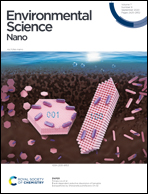Interaction of nano-quantum dots (CdSe@ZnS) and extracellular proteins in activated sludge revealed by bio-nano science†
Abstract
The protein corona has gained much attention in the field of nano-biomedicine and has expanded from applications in the biological field to the ecosphere. However, the bio-corona (extracellular protein corona) composed of nano-quantum dots (CdSe@ZnS) and extracellular proteins in an activated sludge system was limited by the inability to identify the composition and molecular structure of extracellular proteins. Herein, extracellular proteins (EP) were extracted from the active sludge (AS) system and purified by using a novel method (modified-ammonium sulfate precipitate) and then identified by proteomic technology. The interaction between nano-quantum dots and extracellular protein was investigated with multi-spectroscopic technology and microscopic analysis. The results revealed that 97 protein groups were detected and most of their molecular functions were related to the cation binding activity. The self-aggregation effect of protein particles and the formation of the bio-corona were observed. Meanwhile, α-helical structures of EPs in active sludge were converted into β-sheets conformation via electrostatic and hydrogen bonding processes, with the addition of nano-quantum dots, resulting in decreased fluorescence intensities for proteins. This finding not only provided a novel method for the purification of EP from extracellular polymeric substances, but also provided an insight into the interaction between NPs and actual EP in the AS system.



 Please wait while we load your content...
Please wait while we load your content...